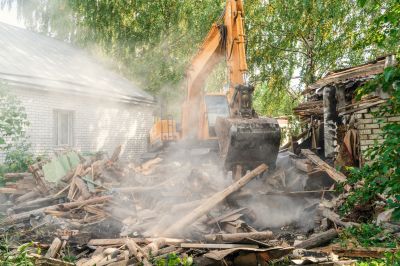Favorite Demolition Equipment for Heavy Construction Tasks
Identify the most trusted and widely used tools to ensure successful and safe demolition operations.
 Demolition projects in Yonkers, NY, require a variety of specialized tools and equipment to ensure efficient and safe operations. From small-scale interior demolitions to large structural tear-downs, selecting the right products is essential for achieving desired results while maintaining safety standards. Proper equipment can help streamline the process, reduce labor intensity, and minimize potential hazards. Whether dealing with residential, commercial, or industrial demolition, having access to quality tools can make a significant difference in project outcomes.
Demolition projects in Yonkers, NY, require a variety of specialized tools and equipment to ensure efficient and safe operations. From small-scale interior demolitions to large structural tear-downs, selecting the right products is essential for achieving desired results while maintaining safety standards. Proper equipment can help streamline the process, reduce labor intensity, and minimize potential hazards. Whether dealing with residential, commercial, or industrial demolition, having access to quality tools can make a significant difference in project outcomes.
Top Overall Option
Heavy-Duty Demolition Hammer
A versatile demolition hammer offers powerful impact force suitable for breaking through concrete, masonry, and other tough materials. Its robust construction and ergonomic design help improve efficiency and reduce operator fatigue, making it a preferred choice for various demolition tasks. Equipped with adjustable settings and safety features, it supports demanding projects while maintaining user safety and comfort.
Types of Products For Demolition Service
Demolition Hammers
Heavy-duty tools designed for breaking concrete, brick, and stone surfaces efficiently.
Rotary Drills
Powerful drills used for drilling into concrete, masonry, and steel structures.
Concrete Saws
Equipment for cutting through concrete, asphalt, and other hard surfaces with precision.
Hydraulic Breakers
Attachment tools for excavators that deliver high-impact force for breaking large concrete or rock.
Jackhammers
Portable pneumatic or electric tools suitable for breaking pavement and small-scale demolition.
Demolition Wedges and Pry Bars
Manual tools used for prying apart materials and dismantling structures.
Safety Gear
Protective equipment including helmets, gloves, goggles, and respirators essential for safe demolition work.
Dust Extraction Systems
Devices designed to reduce airborne dust during cutting and breaking activities.
Scaffolding and Support Structures
Temporary frameworks that provide safe access and support during demolition operations.
Heavy-Duty Dumpsters
Large containers for efficient debris collection and removal from demolition sites.
Wrecking Balls
Large spherical weights used for structural demolition of buildings.
Portable Cut-Off Machines
Compact tools for cutting metal and concrete with ease in confined spaces.
Air Compressors
Power sources for pneumatic tools such as jackhammers and nail guns.
Lifting Equipment
Cranes, hoists, and winches used for moving heavy structural components.
Vibratory Plate Compactors
Tools used for compacting soil or debris after demolition to prepare for new construction.
Hydraulic Spreaders
Tools that assist in dismantling or spreading apart materials during structural demolition.
Popular Choices
Widely used for their portability and ease of use across various demolition tasks.
Popular for their convenience and versatility in drilling through tough materials.
Favored for their precision and efficiency in cutting concrete and asphalt.
Commonly utilized with excavators for heavy-duty demolition projects.
Essential for prying apart materials and dismantling structures manually.
Always in demand for ensuring worker safety during demolition activities.
Increasingly popular for maintaining cleaner work environments.
Trusted for respiratory protection in dusty demolition sites.
Trending for large-scale building demolitions.
Preferred for their quieter operation and reduced exhaust emissions.
In high demand for safe access during multi-story demolitions.
Popular for efficient debris management on busy sites.
Favored for their maneuverability in tight spaces.
Essential for powering pneumatic tools across various demolition tasks.
Commonly used for structural separation and dismantling.
In demolition work, versatility and durability are key factors when choosing products. Heavy-duty hand tools, power equipment, and safety gear are fundamental components that support various tasks such as breaking concrete, removing debris, and dismantling structures. The right selection of equipment can also influence project timelines and overall safety, making it important for professionals and DIY enthusiasts alike to understand the range of available options.
Safety considerations are paramount in demolition projects. Proper protective gear, including helmets, gloves, eye protection, and respirators, should always be prioritized. Additionally, selecting equipment with reliable performance features and appropriate safety mechanisms can help prevent accidents and injuries. As demolition sites can be unpredictable, having adaptable and robust tools ensures that operators can respond effectively to changing conditions.
By investing in high-quality demolition products, professionals in Yonkers can enhance their operational efficiency and safety protocols. It is advisable to evaluate the specific requirements of each project, considering factors such as scope, scale, and environment, to choose the most suitable equipment. With the right tools, demolition work can be carried out more smoothly, efficiently, and safely, ultimately supporting successful project completion.
Key Buying Considerations
- Project scale and scope to determine the appropriate size and power of equipment.
- Material types involved, such as concrete, steel, or masonry, influencing tool selection.
- Portability needs, especially for confined or multi-level demolition sites.
- Power source compatibility, whether electric, pneumatic, or hydraulic.
- Safety features and certifications to ensure compliance with safety standards.
- Durability and build quality for handling tough demolition tasks repeatedly.
- Ease of operation and ergonomic design to reduce operator fatigue.
- Availability of replacement parts and maintenance support.
- Budget constraints balanced with quality and performance requirements.
- Compatibility with existing tools and equipment on-site.
- Noise levels, especially for projects in sensitive environments.
- Dust control capabilities to maintain a cleaner work environment.
- Versatility of tools for multiple demolition applications.
- Speed and efficiency features to optimize project timelines.
- Storage and transportation considerations for the equipment.
